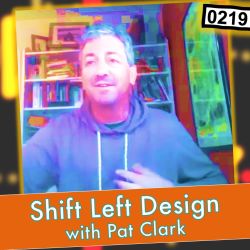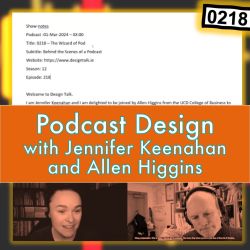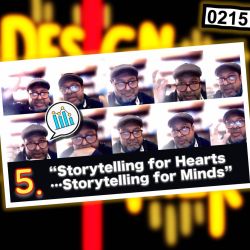Share

Design Talk (dot IE)
0164 - Always Put the Client First with Matteo Collina
Host(s) Emma Matthews and Soumya Seniaray
Our guest today is Matteo Collina, Chief Software Architect at NearForm, the Irish enterprise software solutions company, headquartered in Waterford and offices around the world. Among other things Matteo is an active open-source contributor, is on the steering committee for Node.js, and over his career has developed a deep understanding of the business of consulting…
Thank you for joining us, Matteo, can you start by telling us a little more about yourself?
1. Let’s start with the dark side of the business of consulting, it has a dark side, doesn’t it?
2. And yet the business of consulting is hugely important for client organisations. What does it take to get good at consultancy?
3. How can a services firm ‘flip’ the junior/crunch model?
4. How long does it take to learn how to work with a client organization?
5. What do you say to the idea that it is the consultant’s job to build the knowledge of your own clients?
6. By imparting your knowledge to clients, don’t you cannibalise your own business?
7. Is the analyst role and the consultant role different?
8. Where does design happen; is there room for design in consulting?
9. You're with a client and it becomes clear that they haven't identified the real problem...
10. Any thoughts on how to become a better communicator
11. And finally; does consulting pose ethical challenges, how do you deal with them?
Well on that note, I think we’ll wrap up there.
Thank you for sharing your thoughts and experiences today.
Notes:
Matteo Collina, open-source contributor and member of the Node.js Technical Steering Committee member, Chief Software Architect at NearForm, the Irish enterprise software solutions company.
https://www.nearform.com
Acknowledgements
Music
Title: Impulse
Artist: Ben Prunty
Source: https://www.benpruntymusic.com/
License: Non-transferable license. Permission granted by Ben Prunty (personal letter)
Cover Art
Title: Pick and Mix
Artist: Original artwork by Conor Fitzpatrick; additional graphic design: Allen Higgins
Source: Fitzpatrick_Unamed.jpg -> PickAndMix-Name.pptx
License: CC BY-NC-SA 4.0 (Permission granted by Conor Fitzpatrick (personal letter))
Podcast License
Design Talk (dot IE) CC BY-NC-SA 4.0
The license can be viewed at https://creativecommons.org/licenses/by-nc-sa/4.0
By taking part you give permission for your voice to be recorded, for the recording to be edited, and for it to be posted and published as a podcast.
More episodes
View all episodes

219. 0219 - Shift Left Design with Pat Clark
42:05Today I talk with Pat Clark, Senior Staff Engineer at ChargePoint, responsible for the Driver Portal and other web services. Pat is a unique blend of entrepreneur and software engineer with a passion for good design. This will be a provocative conversation about the state of the internet for people with disabilities and diverse needs.So, let’s start with this idea that Accessibility is the Zeroth usability requirement, that we’ve got to consider it in parallel with every other requirement, everywhere, all the time, all at once.Q: Why? Why bake accessibility into everything, why bring it into focus, and how do start the process?Q: What skills do you see as essential? Q: Can you talk about some examples?Q: You called it an ARIA label, so basically, nearly all access problem is an HTML problem.Q: what QA tools do you have in your toolbox. Q: What about installing overlays... Q: What if you break something? Q: You may be putting an awful lot of work into address a small and shrinking portion of the population.Q: Does accessibility affect you personally?Q: Let's finish on an observation that some of the foundational technologies developed for accessibility have gone on to improve everyone's experience of the web. Q: Is there anything else you’d like to add before we wrap-up?.Notes:https://www.chargepoint.com/en-gb/https://driver.chargepoint.com/ (driver portal)https://www.w3.org/WAI/people-use-web/tools-techniques/https://developer.mozilla.org/en-US/docs/Web/Accessibility/ARIA/Attributes/aria-labelAcknowledgementsMusic Title: The WorldArtist: Ben Prunty (2012)Source: https://www.benpruntymusic.com/License: Non-transferable license. Permission granted by Ben PruntyCover Art Title: Screenshot+HighContrast+GlowDiffusedArtist: Allen HigginsSource: podcast-PatAllen.pptxLicense: CC BY-NC-SA 4.0Podcast LicenseDesign Talk (dot IE) CC BY-NC-SA 4.0 The license can be viewed at https://creativecommons.org/licenses/by-nc-sa/4.0By taking part you give permission for your voice to be recorded, for the recording to be edited, and for it to be posted and published as a podcast.
218. 0218 - Podcast design with Jennifer Keenahan and Allen Higgins
24:14Welcome to Design Talk.I am Jennifer Keenahan and I am delighted to be joined by Allen Higgins from the UCD College of Business to talk about shaping and delivering a podcast.Today I have turned the tables on Allen. Usually, he’s behind the scenes directing the show. Today I want him to share what goes into planning and producing an episode.To start, Allen could you tell us a little about your background and how you came to bring podcasting into your teaching practice.Q: Let’s start with your teaching pod, Design Talk. You had this idea that you wanted to make a podcast, how did you start? Q: So, let’s say I have an idea that I want to make a podcast. How do I start? Q: What kinds of pods are there; how do you choose one? Q: Let’s talk a bit more about format. Q: How do you organise or structure your own pod? Q: What is the key to a strong interview? Q: So, sticking with interviews, how do you prepare?Q: Questions from the audience?Q: Is there anything you’d like add?Mentions, links and notes:Jennifer Keenahan (link)Mairéad O’Reilly – (link)Allen Higgins (link)Ruth Campion (link). Ruth is a game designer and 3D artistConor Reid (link). Conor hosts and produces his own award-winning arts and culture podcast, Words To That EffectSiobhán McHugh (link). Siobhán is an Irish-Australian author, podcast producer and critic, oral historian, audio documentary-maker and journalism academic.Audacity (link). Audacity is a freely available open-source DAW, a Digital Audio Workstation; a highly regarded and extremely capable software environment for audio engineering.AcknowledgementsMusic Title: Voltaic FluctuationsArtist: Ben PruntySource: https://www.benpruntymusic.com/License: Non-transferable license. Permission granted by Ben PruntyCover Art Title: Complex collageArtist: Allen HigginsSource: vignette_version.pptxLicense: CC BY-NC-SA 4.0Podcast LicenseDesign Talk (dot IE) CC BY-NC-SA 4.0 The license can be viewed at https://creativecommons.org/licenses/by-nc-sa/4.0By taking part you give permission for your voice to be recorded, for the recording to be edited, and for it to be posted and published as a podcast.
215. 0215 - Storytelling with Moin
01:03:21Hosted by Christina Phillips.We are proud to announce this seminar with Dr S M A Moin, a Senior Lecturer (Associate Professor) in Marketing at Queen Mary University of London, and Director of Teaching Associates at the School of Business. He is an interdisciplinary researcher and a published author in brand storytelling, strategy, leadership and creativity & innovation.Storified and creative teaching can break the clutter and connect with students’ rational brains by tapping into their emotions.Further reading, sources, mentions and acknowledgements.S. M. A. Moin. Creativity in the Imagination Age. Springer Books, (2022). S. M. A. Moin. Brand Storytelling in the Digital Age: Theories, practice and application. London: Palgrave Macmillan, (2020).Kay Peterson and David A. Kolb. How you learn is how you live: Using nine ways of learning to transform your life. Berrett-Koehler Publishers, (2017).HBP editors. Why your students are disengaged and and what you can do to draw them back in. Harvard Business Publishing, (2022)Joseph Campbell. The Hero with a Thousand Faces. Various publishers, (1949-2008)Alighieri Dante. The Divine Comedy. Various publishers, (-2017).Contact details:S M A Moin -- https://www.linkedin.com/in/smamoin/ Christina -- https://www.linkedin.com/in/christinajphillips/A video version of this episode is published on the Business Analytics Educators Forum’s YouTube channel at: AcknowledgementsMusic Title: Guitar HouseArtist: josh pan (2020)Source: https://www.youtube.com/watch?v=JL-LId8ZWBMLicense: License CC BY 3.0Cover Art Title: Complex collaboration for BAEFArtist: Nuno Machado and Allen HigginsSource: vignette_version.pptxLicense: CC BY-NC-SA 4.0Podcast LicenseDesign Talk (dot IE) CC BY-NC-SA 4.0 The license can be viewed at https://creativecommons.org/licenses/by-nc-sa/4.0By taking part you give permission for your voice to be recorded, for the recording to be edited, and for it to be posted and published as a podcast.
217. 0217 - Data Engineering with Julian Wiffen
43:04I am delighted to have Julian Wiffen to talk about some of the latest breakthroughs in generative AI and their application to data engineering.Julian is Director of Data Science for the Product team at Matillion.· To start, Julian could you share a little about your background in Data Science and introduce us to Matillion and its mission?· How does an independent services solutions company leverage while adding value to the models generated by the large LLM developers?· Can you share your some of the learning and discoveries you’ve made by researching and applying Gen AI to data engineering? · Can you share your thoughts on its impact on the way data science is done? [· What do you consider to be the entry-level skillset? · How do you approach teaching and learning skills in the area and what tips would you give a university educator?· On the topic of regulation and ethics for data scientists working with Gen AI. There is talk of mandating the 'human in the loop' approach for safety, that may even become regulation. How you see ‘human in the loop’ working?· Who are the key data science authors and media you refer to? [books, blogs, pods] · Is there anything you’d like add?Notes:Julian’s blogs at Matillion· Matillion: The Data Engineer’s Guide to Prompt Engineering part 1 (link)· Matillion: The Data Engineer’s Guide to Prompt Engineering part 2 (link)· Matillion: The Data Engineer’s Guide to Prompt Engineering part 3 (link)· Matillion: Evaluating the performance of different LLMs (link) Recommended to follow Andrew Ng, researcher-entrepreneur (homepage)AcknowledgementsMusic Title: The WorldArtist: Ben Prunty (2012)Source: https://www.benpruntymusic.com/License: Non-transferable license. Permission granted by Ben PruntyCover Art Title: Complex collaboration for BAEFArtist: Nuno Machado and Allen HigginsSource: vignette_version.pptxLicense: CC BY-NC-SA 4.0Podcast LicenseDesign Talk (dot IE) CC BY-NC-SA 4.0 The license can be viewed at https://creativecommons.org/licenses/by-nc-sa/4.0By taking part you give permission for your voice to be recorded, for the recording to be edited, and for it to be posted and published as a podcast.
216. 0216 - How to leverage managed services as a vehicle for business growth with Scott Bewley and Ryan Hayes from PwC
34:31"How to leverage managed services as a vehicle for business growth" with Scott Bewley and Ryan Hayes from PwC"Hosts: Saisnehha Natraj and Kushagra Mehrotra What experiences do each of you have in the arena of outsourcing?According to you, what are the dimensional considerations for outsourcing?How have things changed since covid in the marketplace, in terms of outsourcing?Do you think the outsourcing practices are different across various sectors and countries?How do you keep your customer satisfied?What do you think about AI’s role in outsourcing?Audience Questions.Thank you for listening.NOTES:AcknowledgementsMusic Title: Voltaic FluctuationsArtist: Ben PruntySource: https://www.benpruntymusic.com/License: Non-transferable license. Permission granted by Ben PruntyCover Art Title: Aspects of OutsourcingArtist: Group W (Junjie, Aman, Kushagra, Snehha and Subhashini)Source: Scott_and_Ryan_Cover_Art.pptxLicense: CC BY-NC-SA 4.0 Podcast LicenseDesign Talk (dot IE) CC BY-NC-SA 4.0 The license can be viewed at https://creativecommons.org/licenses/by-nc-sa/4.0By taking part you give permission for your voice to be recorded, for the recording to be edited, and for it to be posted and published as a podcast.
67. 0067 - Delivering from a Distance with Ajaya Singh
26:34Interview with Ajaya Singh, True North AR India Pvt. Ltd, Gurgaon.Podcast team: Jack Daly, Shachi Parmar, Jennifer Kevany, and Ronan Brennan[Jack] (Intro) Good morning and welcome to the Design Talk podcast.So, today we are talking with Ajaya Singh, from True North AR, a Medical Process Outsourcing (MPO) services provider. To date in our podcasts we have gained some fantastic insight into the opportunities and challenges in outsourcing/Offshoring from the client perspective , this morning we have a great opportunity to understand this process from the service provider's perspective.( Sales) The challenges of getting new contracts, new client development, building a sales pipeline, from a distance?( MPO vs BPO) How is MPO different from ITO or general BPO?( Advantages/challenges) What are the advantages of operating from Gurgaon/India? Challenges?( Recruitment process) How do you bring new hires on board? ( Client Trust) Building trust is a substantial part of an effective relationship for a client's perspective, how would you look to build such trust and how do you maintain it? ( reducing anxiety)(Cultural differences and provider trust)We spoke about the cultural differences between India and the US discussing the societal view on bankruptcy, how do you overcome issues like this and how do you trust clients?- how do you overcome cultural differences and bias?( Disagreements)Like all business , leaders and owners can be passionate but perhaps at time misinformed, now do you manage power dynamics and disagreements without being cold i.e “ out of scope”( Recent LifeCyle) Can you tell us about the life cycle of a recent project - what are the most important factors for a successful project?( Cost efficiencies ) We spoke about cost and ensuring cost efficiencies , using lesser skilled labour when possible, can you talk a bit more on this( Societal impact) A substantial part of this course is reviewing the impact to society of a FDI investment,. how important is this, and how much responsibility do the local regions take to attract such investment.. eg dublin chamber and “ why dublin campaign”( Risks and competition)What are the current risks to your business and industryeg we hear alot about emerging nations competing for investment and contract, also the rise of machine learning and AI, how do you manage competitionCLOSINGSo, on that note…( thank guest, thank audience) We would like to thank you for making time in your busy schedule to talk to us today, from the other side of the planet.And for sharing your knowledge and insights into delivering services from a distance.AcknowledgementsMusic Title: “It was just cold” (2018)Artist: Andrew R CodemanSource: https://bit.ly/2MsarcjLicense: CC BY 4.0Cover Art Title: Cartoon charactersArtist: Student team and Allen HigginsSource: Background image.PNGLicense: CC BY-NC-SA 4.0Podcast LicenseDesign Talk (dot IE) CC BY-NC-SA 4.0 The license can be viewed at https://creativecommons.org/licenses/by-nc-sa/4.0By taking part you give permission for your voice to be recorded, for the recording to be edited, and for it to be posted and published as a podcast.
64. 0064 - Supplier Partnership with Bernard Harris
41:16Welcome to Design Talk.In this episode we speak with Bernard Harris, Head of Trust & Safety for TikTok, EMEA.This pod was recorded on Tuesday 9th February 2021.Podcast title and guest: Talking with Bernard Harris from TikTock.Introduction by Fouz Alsubaie. Interview hosted by Caroline Willis, Cristina Primavera, Emma Ji, Danny Coss Heneghan, and Veronika Pushkina.AcknowledgementsMusic Title: “It was just cold” (2018)Artist: Andrew R CodemanSource: https://bit.ly/2MsarcjLicense: CC BY 4.0Cover Art Title: Think Lab Studio + Abadi MTArtist: Allen HigginsSource: AudioStudio-GeorgeMooreBuilding.pptxLicense: CC BY-NC-SA 4.0Podcast LicenseDesign Talk (dot IE) CC BY-NC-SA 4.0 The license can be viewed at https://creativecommons.org/licenses/by-nc-sa/4.0By taking part you give permission for your voice to be recorded, for the recording to be edited, and for it to be posted and published as a podcast.
214. 0214 - BAEF Future of Work Panel
01:04:23This BAEF Future of Work Panel titled "Embracing the Fourth Industrial Revolution" took place on December 14, 2023. Our panelists were:* Luke Vilain, Data Ethics and AI Risk Specialist, working in financial services.* Balagopal (Bala) Madhusoodhanan, a intelligent automation architect working on Low Code / No Code platforms and AI risk classification.* James Winters, an AI consultant who develops strategies and governance solutions to help solve business problems.* Marilena Karanika, Data Scientist, working in financial services modelling and analyticsFurther reading and interesting takeaways...* Discovering ethical challenges and future conundrums? Play the moral machines game --- www.moralmachine.net* Recommendations for ‘must watch’ long form media? Watch The Social Dilemma (2020) -- https://www.imdb.com/title/tt11464826* “Generative artificial intelligence (AI) in education” policy paper - GOV.UK (2023) -- https://bit.ly/3RXgCbK* AI for Humanity -- https://mila.quebec/en/ai-for-humanity/* Consequence Scanning, an agile toolkit -- from https://doteveryone.org.uk see https://bit.ly/3Hwv8SNA video version of this episode is published on the Business Analytics Educators Forum’s YouTube channel at: https://www.youtube.com/channel/UCrPQ1nwQVmvGUpKN0pey27gAcknowledgementsMusic Title: Guitar HouseArtist: josh pan (2020)Source: https://www.youtube.com/watch?v=JL-LId8ZWBMLicense: License CC BY 3.0Cover Art Title: Complex collaboration for BAEFArtist: Nuno Machado and Allen HigginsSource: vignette_version.pptxLicense: CC BY-NC-SA 4.0Podcast LicenseDesign Talk (dot IE) CC BY-NC-SA 4.0 The license can be viewed at https://creativecommons.org/licenses/by-nc-sa/4.0By taking part you give permission for your voice to be recorded, for the recording to be edited, and for it to be posted and published as a podcast.
213. 0213 - Phenomenology & Technology Part 2 - Lucas Introna
01:12:56The following episode is a bonus cross-pod publication (pollination?) between “Design Talk” and “CITO Conversations” a research community pod hosted by University College Dublin’s Centre for Innovation, Technology & Organisation.This ‘from the archives’ recording is the second part of the keynote from “ Triangular Conference 2008” in which Dermot Moran and Lucas Introna talk about the value of conducting research in the phenomenological tradition and considerations when carrying out research into organisations, information systems and modern technology.Part 2In part two Lucas argues that Phenomenology offers deep insights into fundamental aspects of the human experience of technology and information systems, with implications for the sociology of Management and Organisation. The talk was recorded in-person with a live audience on Thursday June the 5th 2008 in the UCD Lochlann Quinn Undergraduate School of Business, Belfield, Dublin, Ireland.Acknowledgements Music Title: Adagio in G minorArtist: Remo Giazotto attributed to Tomaso AlbinoniSource: https://soundcloud.com/dick-de-ridder/adagio-in-g-minor-albinoniLicensed by Dick de Ridder: CC-BY 3.0 Cover Art Title: Discussion at the conference dinnerArtist: Allen HigginsSource: Collage/various (podcast-MoranIntrona_01.pptx)License: CC BY-NC-SA 4.0 Podcast LicenseDesign Talk (dot IE) CC BY-NC-SA 4.0 The license can be viewed at https://creativecommons.org/licenses/by-nc-sa/4.0By taking part you give permission for your voice to be recorded, for the recording to be edited, and for it to be posted and published as a podcast.